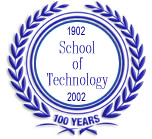
"Technology
and Us"
School of Technology
Centennial Symposium
An Extended Celebration

 |
"Technology
and Us" |
 |
|
|
A Century
of Physics and Technology The
interaction between physics and technology for the last century, and for
the foreseeable future, has been an intricate dance, first one, and then
the other, leading at a pace of such rapidity and with such unexpected
twists and turns that the results have been at once breathtaking and beautiful
yet quite often surprising. There is no doubt that the basic pattern of
science originated from direct sensory observation and that empirical
breakthroughs were both caused by and resulted in the breakdown of technological
barriers. Early on patterns of observation were codified and quantified
in simple mathematical expressions uncovered by the likes of Kepler, Galileo
and Newton, in a formalism known today as classical mechanics. The classical
world provided a reassuring philosophical view embedded in the notions
of causality and determinism. Although this clockwork universe left little
room for free will it ushered in a confidence and sureness to science
that was built over centuries of success. **************************************************** An outline of a chapter with the above title in a "Technology and Us" book. Find terms you can't quite understand? Stay tuned! Meanwhile, here is the road map: I. Introduction-
It's all atoms-quantization- it's atoms all the way down II.
Atoms and Quarks III.
Large Scale Structure: Going to the Beginning V. Conclusion |